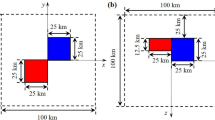Abstract
There exist three types of convolution formulae for the efficient evaluation of gravity field convolution integrals, i.e., the planar 2D convolution, the spherical 2D convolution and the spherical 1D convolution. The largest drawback of both the planar and the spherical 2D FFT methods is that, due to the approximations in the kernel function, only inexact results can be achieved. Apparently, the reason is the meridian convergence at higher latitudes. As the meridians converge, the †ϕ,†λ blocks do not form a rectangular grid, as is assumed in 2D FFT methods. It should be pointed out that the meridian convergence not only leads to an approximation error in the kernel function, but also causes an approximation error during the implementation of 2D FFT in computer. In order to meet the increasing need for precise determination of the vertica deflections, this paper derives a more precise planar 2D FFT formula for the computation of the vertical deflections. After having made a detailed comparison between the planar and the spherical 2D FFT formulae, we find out the main source of errors causing the loss in accuracy by applying the conventional spherical 2D FFT method. And then, a modified spherical 2D FFT formula for the computation of the vertical deflections is developed in this paper. A series of numerical tests have been carried out to illustrate the improvement made upon the old spherical 2D FFT. The second part of this paper is to discuss the influences of the spherical harmonic reference field, the limited capsize, and the singular integral on the computation of the vertical deflections. The results of the vertical deflections over China by applying the spherical 1D FFT formula with different integration radii have been compared to the astro-observed vertical deflections in the South China Sea to obtain a set of optimum deflection computation parameters.
Similar content being viewed by others
References
Featherstone W E, Sideris M G. Modified kernels in spectral geoid determination-first results from Western Australia. In: IAG Symposia 119, Geodesy on the Move Gravity, Geoid, Geodynamics, and Antarctica. Germany: Springer-Verlag Berlin Heidelberg, 1997. 188–193
Forsberg R. Gravity field terrain effect computation by FFT.Bulletin Geodesique, 1985, 59(3):342–360
Forsberg R, Siders M G. Geoid computations by the multi-banding spherical FFT approach.Manuscripta Geodaetica, 1993, 18(2):82–90
Forsberg R, Sideris M G. Testing the spherical FFT formula for the geoid over large regions. The AGU Spring '91 meeting, Baltimore, 1991
Forsberg R, Featherstone W E. Geoids and cap sizes. In: IAG Symposia 119, Geodesy on the Move Gravity, Geoid, Geodynamics, and Antarctica. Germany: Springer-Verlag Berlin Heidelberg, 1997:194–200
Haagmans R, de Min E, van Gelderen M. Fast evaluation of convolution integrals on the sphere using 1DFFT, and a comparison with existing methods for Stokes' integral.Manuscripta Geodaetica, 1993, 18(5):227–241
Heiskanen W, Moritz H. Physical Geodesy. San Francisco: Freeman and Company, 1967
Higgins M, Forsberg R, Kearsley A H W. The effects of varying cap sizes on geoid computations-experiences with FFT and ring integration. In: IAG Symposia 119, Geodesy on the Move Gravity, Geoid, Geodynamics, and Antarctica. Germany: Springer-Verlag Berlin Heidelberg, 1997. 201–206
Huang M T, Guan Z, Zhai G J. Method of extending high degree geopotential model using altimeter-derived marine gravity anomalies and the local data in China. Symposium for the Fortieth anniversary of Chinese Society of Geodesy, Photogrammetry and Cartography, 1999. 203–210 (in Chinese)
Huang C. Global derivation of marine gravity anomalies from SEASAT, Geosat, ERS-1 and TOPEX/POSEIDON altimeter data.Geophysical Journal International, 1998, 134:449–459
Li J C, Ning J S, Chao D B. Comments on two dimensional convolution of the geodetic problems in planar and spherical coordinates. In: IAG Symposia 119, Geodesy on the Move Gravity, Geoid, Geodynamics, and Antarctica. Germany: Springer-Verlag Berlin Heidelberg, 1997. 219–224
Liu Q W, Li Y C, Sideris M G. Evaluation of deflections of the vertical on the sphere and the plane: a comparison of FFT techniques.Journal of Geodesy, 1997, 71 (8): 461–468
Ning J S, Chao D B, Li J C. The spherical convolution form of Vening-Meinesz formula.Acta Geodaetica et Cartographica Sinica, 1994, 23(3):161–166 (in Chinese)
Schwarz K P, Sideris M G, Forsberg R. The use of FFT techniques in physical geodesy.Geophysical Journal International, 1990, 100(6):485–514
Sideris M G. Geoid determination by FFT technqiues. International School for the Determination and Use of the Geoid, Lecture Notes, Milan, 1994
Sideris M G. A fast Fourier transform method of computing terrain corrections.Manuscripta Geodaetica, 1985, 10(1):66–73.
van Strang Hees G. Stokes' formula using fast Fourier techniques.Manuscripta Geodaetica, 1990, 15(4):235–239
Zhang C, Sideris M G. Oceanic gravity by analytical inversion of Hotine's formula.Marine Geodesy, 1996, 19 (12):115–136
Author information
Authors and Affiliations
Corresponding author
About this article
Cite this article
Motao, H., Guojun, Z., Zheng, G. et al. On the evaluation of deflections of the vertical using FFT technique. Geo-spat. Inf. Sci. 4, 5–13 (2001). https://doi.org/10.1007/BF02826629
Issue Date:
DOI: https://doi.org/10.1007/BF02826629




